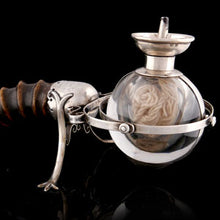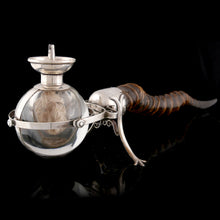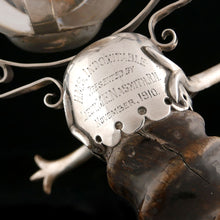HMS Indomitable - Wardroom Cigar Table Lighter, 1897
- Regular price
- £2,400
- Sale price
- £2,400
- Regular price
-
- Unit price
- /per
Adding product to your cart
Length: 40cm (15.7in)
Provenance: Admiral Sir Martin Eric Dunbar-Nasmith VC, RN
Silver mounted cigar lighter in the form of a gimballed glass reservoir for stability at sea, supported on stylised dragon’s feet and a tail formed from an Indian Blackbuck antelope horn. Inscribed: H.M.S. Indomitable / Presented by / Lieut. M.E. Nasmith RN / November 1910’. Maker’s mark of Gourdel Vales & Co, Great Marlborough Street, London. Hallmaked London 1897.
Read more

Admiral Sir Martin Eric Dunbar-Nasmith VC, KCB, KCMG (1883-1965) commanded one of the most successful submarines in the Dardanelles Campaign of 1915, sinking more than 80 vessels of all sizes in three tours of the Sea of Marmara. He entered the navy in 1898 and was promoted midshipman in 1900. He served in the battleship Renown on the North America and West Indies Station before selection for ‘Submarine Training’. He subsequently commanded HM Submarines A4 and C7. He returned to the surface fleet with an appointment to the battlecruiser HMS Indomitable from 1908 to 1911. In 1912, when fog disrupted a naval review at Weymouth, Nasmith fulfilled a request from George V to experience a dived ‘run’ in the first gun-mounted submarine, D4. This responsibility was further compounded by the additional presence of naval cadet Prince Albert (future George VI), Winston Churchill (First Lord of the Admiralty), a former prime minister Arthur Balfour and the Inspecting Captain of Submarines, Roger Keyes.
At the start of the First World War Nasmith was appointed to the command HM Submarine E11 in the North Sea. After an unsuccessful attempt to enter the Baltic in late 1914, E11 was sent to the Dardanelles in company with Submarines E14 and E15 in March 1915. It was here that Nasmith won the Victoria Cross for an act of audacity in the wake of a highly successful war patrol in which he destroyed a large Turkish gunboat, two transports, one ammunition ship, three store ships and four other vessels.
‘When he had safely passed the most difficult part of his homeward journey he received information that a cargo of coal was heading towards Istanbul from the Black Sea. Realising that coal was essential for the morale of the besieged city, Nasmith turned back. When the coal-carrying ship came into sight of the docks, a welcoming committee of municipal grandees soon formed, along with a happy crowd – water, electricity and rail transport had all suffered due to a lack of coal. Hardly had the ship berthed than it mysteriously blew up before the eyes of the astounded crowd. Nasmith successfully slipped out again.’
His VC citation continues: ’Nasmith conducted combat operations in the Sea of Marmara for a three-month period. When his torpedoes ran low, he set them to float at the end of their run, so that he could recover them should they fail to hit a target. At one point, he captured a sailing dhow, and lashed it to the conning tower of E11 as camouflage, and went on to capture an ammunition ship using small arms. His penetration of the Golden Horn was the first time an enemy ship had done so in over 500 years. He also attacked a railway viaduct.’
Nasmith was promoted and appointed to the command of the Seventh Submarine Flotilla in the Baltic and Senior Naval Officer at Reval (later Tallinn). On his marriage in 1923 he took the additional name of Dunbar. He served as captain of HMS Iron Duke from 1921 to 1923, and was Commandant of the Royal Naval College, Dartmouth, before becoming Rear Admiral Submarines in 1929. He became Commander-in-Chief, East Indies in 1932 and Second Sea Lord in 1935. He was Commander-in-Chief, Plymouth from 1938 and Commander-in-Chief of Plymouth and Western Approaches Command from the outbreak of war in September 1939. He served as Flag Officer-in-Charge, London from 1942. After the war Admiral Dunbar-Nasmith settled in Glen of Rothes, Morayshire, Scotland. In retirement he became Vice Chairman of the Imperial War Graves Commission.









